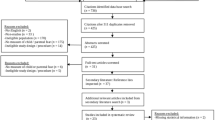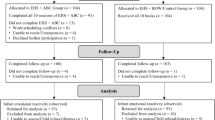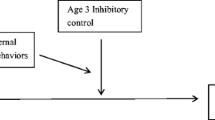Abstract
This study tested bidirectional relations between infant high-intensity fear and fear regulation over 1.5 years, and maternal sensitivity and depressive symptoms as moderators. Participants were 1,292 mother-infant pairs prospectively assessed at three times when infants were 6, 15, and 24 months old. Infant high-intensity fear and fear regulation (avoidance, orienting to mother, attention regulation, and self-soothing) were observed during the Mask Task at each of these time points. Likewise, mothers reported their depressive symptoms, and their sensitivity was observed in a separate mother–child interaction task at each time point. Conditional multilevel growth models revealed that highly avoidant infants exhibited less initial high-intensity fear, but faster growth in high-intensity fear over time. Furthermore, highly avoidant infants exhibited more concurrent high-intensity fear when their mothers demonstrated low sensitivity. Unexpectedly, when their mothers were highly depressed, infants who used more attention regulation demonstrated more rapid growth of high-intensity fear over time. Finally, when their mothers were not depressed, infants exhibiting more high-intensity fear oriented more to their mothers concurrently. When their mothers reported high depressive symptoms over time, infants with more high-intensity fear initially oriented less to their mothers but more rapidly increased orienting to their mothers over time. Findings reveal the interplay between infant and maternal factors over time in development of infant high-intensity fear. In particular, maternal sensitivity protected highly fearful infants by rapidly reducing fear reactivity despite infant avoidance. In contrast, high maternal depressive symptoms introduced both immediate and enduring risks for infant fear development. Clinical implications are discussed.


Similar content being viewed by others
Availability of Data and material
The data that support the findings of this study are openly available in the Inter-university Consortium for Political and Social Research at https://doi.org/10.3886/ICPSR34602.v4, reference number ICPSR 34,602.
References
Ainsworth, M. D. S., Blehar, M. C., Waters, E., & Wall, S. (1978). Patterns of attachment: A psychological study of the strange situation. Hilsdale, NJ: Lawrence Erlbaurn.
Al-Shawaf, L., Conroy-Beam, D., Asao, K., & Buss, D. M. (2016). Human emotions: An evolutionary psychological perspective. Emotion Review, 8, 173–186. https://doi.org/10.1177/1754073914565518
Babineau, V., Green, C. G., Jolicoeur-Martineau, A., Bouvette-Turcot, A. A., Minde, K., Sassi, R., & Lydon, J. (2015). Prenatal depression and 5-HTTLPR interact to predict dysregulation from 3 to 36 months–A differential susceptibility model. Journal of Child Psychology and Psychiatry, 56, 21–29. https://doi.org/10.1111/jcpp.12246
Barnett, M. A., & Scaramella, L. V. (2017). Supportive and intrusive parenting during early childhood: Relations with children’s fear temperament and sex. Journal of Family Psychology, 31, 553–562. https://doi.org/10.1037/fam0000304
Barrett, L. F., Mesquita, B., Ochsner, K. N., & Gross, J. J. (2007). The experience of emotion. Annual Review Psychology, 58, 373–403. https://doi.org/10.1146/annurev.psych.58.110405.085709
Beacon, H. J., & Thompson, S. G. (1996). Multi-level models for repeated measurement data: Application to quality of life data in clinical trials. Statistics in Medicine, 15, 2717–2732. https://doi.org/10.1002/(SICI)1097-0258(19961230)15:24%3c2717::AID-SIM518%3e3.0.CO;2-E
Braungart-Rieker, J. M., Hill-Soderlund, A. L., & Karrass, J. (2010). Fear and anger reactivity trajectories from 4 to 16 months: The roles of temperament, regulation, and maternal sensitivity. Developmental Psychology, 46, 791–804. https://doi.org/10.1037/a0019673
Boyce, W. T., & Ellis, B. J. (2005). Biological sensitivity to context: I. An evolutionary–developmental theory of the origins and functions of stress reactivity. Development and Psychopathology, 17, 271–301. https://doi.org/10.1017/S0954579405050145
Buss, K. A. (2011). Which fearful toddlers should we worry about? Context, fear regulation, and anxiety risk. Developmental Psychology, 47, 804–819. https://doi.org/10.1037/a0023227
Buss, K. A., & Goldsmith, H. H. (1998). Fear and anger regulation in infancy: Effects on the temporal dynamics of affective expression. Child Development, 69, 359–374. https://doi.org/10.1111/j.1467-8624.1998.tb06195.x
Calkins, S. D., & Hill, A. (2007). Caregiver influences on emerging emotion regulation: Biological and environmental transactions in early development. In J. J. Gross (Ed.), Handbook of emotion regulation (pp. 229–248). Guilford Press.
Cole, P. M., Bendezú, J. J., Ram, N., & Chow, S. M. (2017). Dynamical systems modeling of early childhood self-regulation. Emotion, 17, 684–699. https://doi.org/10.1037/emo0000268
Cole, P. M., Martin, S. E., & Dennis, T. A. (2004). Emotion regulation as a scientific construct: Methodological challenges and directions for child development research. Child Development, 75, 317–333. https://doi.org/10.1111/j.1467-8624.2004.00673.x
Cox, M. J., Paley, B., Burchinal, M., & Payne, C. C. (1999). Marital perceptions and interactions across the transition to parenthood. Journal of Marriage and Family, 61, 611–625. https://doi.org/10.2307/353564
Degnan, K. A., Hane, A. A., Henderson, H. A., Walker, O. L., Ghera, M. M., & Fox, N. A. (2015). Emergent patterns of risk for psychopathology: The influence of infant avoidance and maternal caregiving on trajectories of social reticence. Development and Psychopathology, 27, 1163–1178. https://doi.org/10.1017/S0954579415000747
Derogatis, L. R. (2000). BSI 18, Brief Symptom Inventory 18: administration, scoring, and procedures manual. NCS Pearson. Inc.: Minneapolis, MN, USA.
Dix, T., Meunier, L. N., Lusk, K., & Perfect, M. M. (2012). Mothers’ depressive symptoms and children’s facial emotions: Examining the depression–inhibition hypothesis. Development and Psychopathology, 24, 195–210. https://doi.org/10.1017/S0954579411000770
Ekas, N. V., Lickenbrock, D. M., & Braungart-Rieker, J. M. (2013). Developmental trajectories of emotion regulation across infancy: Do age and the social partner influence temporal patterns. Infancy, 18, 729–754. https://doi.org/10.1111/infa.12003
Enders, C. K., & Bandalos, D. L. (2001). The relative performance of full information maximum likelihood estimation for missing data in structural equation models. Structural Equation Modeling, 8, 430–457. https://doi.org/10.1207/S15328007SEM0803_5
Feldman, R., Granat, A., Pariente, C., Kanety, H., Kuint, J., & Gilboa-Schechtman, E. (2009). Maternal depression and anxiety across the postpartum year and infant social engagement, fear regulation, and stress reactivity. Journal of the American Academy of Child & Adolescent Psychiatry, 48, 919–927. https://doi.org/10.1097/CHI.0b013e3181b21651
Feng, X., Shaw, D. S., Kovacs, M., Lane, T., O'Rourke, F. E., & Alarcon, J. H. (2008). Emotion regulation in preschoolers: The roles of behavioral inhibition, maternal affective behavior, and maternal depression. Journal of Child Psychology and Psychiatry, 49, 132–141. https://doi.org/10.1111/j.1469-7610.2007.01828.x
Gartstein, M. A., Bridgett, D. J., Rothbart, M. K., Robertson, C., Iddins, E., Ramsay, K., & Schlect, S. (2010). A latent growth examination of fear development in infancy: Contributions of maternal depression and the risk for toddler anxiety. Developmental Psychology, 46, 651–668. https://doi.org/10.1037/a0018898
Gazelle, H., & Spangler, T. (2007). Early childhood anxious solitude and subsequent peer relationships: Maternal and cognitive moderators. Journal of Applied Developmental Psychology, 28, 515–535. https://doi.org/10.1016/j.appdev.2007.06.006
Goldsmith, H., & Rothbart, M. K., (1996). Prelocomotor and locomotor laboratory temperament assessment battery, Lab-TAB; version 3.0, technical manual. Madison: University of Wisconsin, Department of Psychology.
Gross, J. J., & Jazaieri, H. (2014). Emotion, emotion regulation, and psychopathology: An affective science perspective. Clinical Psychological Science, 2, 387–401. https://doi.org/10.1177/2167702614536164
Hemphill, J. F. (2003). Interpreting the magnitudes of correlation coefficients. American Psychologist, 58, 78–79. https://doi.org/10.1037/0003-066X.58.1.78
Izard, C. E. (2009). Emotion theory and research: Highlights, unanswered questions, and emerging issues. Annual Review of Psychology, 60, 1–25. https://doi.org/10.1146/annurev.psych.60.110707.163539
Kappas, A. (2011). Emotion and regulation are one! Emotion Review, 3, 17–25. https://doi.org/10.1177/1754073910380971
Keeley, J., Zayac, R., & Correia, C. (2008). Curvilinear relationships between statistics anxiety and performance among undergraduate students: Evidence for optimal anxiety. Statistics Education Research Journal, 7, 4–15.
Kiel, E. J., Price, N. N., & Premo, J. E. (2020). Maternal comforting behavior, toddlers’ dysregulated fear, and toddlers’ emotion regulatory behaviors. Emotion, 20, 793–803. https://doi.org/10.1037/emo0000600
Mills-Koonce, W. R., Wagner, N. J., Willoughby, M. T., Stifter, C., Blair, C., Granger, D. A., et al. (2015). Greater fear reactivity and psychophysiological hyperactivity among infants with later conduct problems and callous-unemotional traits. Journal of Child Psychology and Psychiatry, 56, 147–154. https://doi.org/10.1111/jcpp.12289.
Morales, S., Ram, N., Buss, K. A., Cole, P. M., Helm, J. L., & Chow, S. M. (2018). Age-related changes in the dynamics of fear-related regulation in early childhood. Developmental Science, 21, e12633. https://doi.org/10.1111/desc.12633
Morris, A. S., Criss, M. M., Silk, J. S., & Houltberg, B. J. (2017). The impact of parenting on emotion regulation during childhood and adolescence. Child Development Perspectives, 11, 233–238. https://doi.org/10.1111/cdep.12238
Muthén, B. O., & Muthén, L. K., (2017). Mplus, Version 8 [Computer Software]. Los Angeles, CA.
NICHD Early Child Care Research Network. (1999). Child care and mother-child interaction in the first 3 years of life. Developmental Psychology, 35, 1399–1413. https://doi.org/10.1037/0012-1649.35.6.1399
Pelaez, M., Virues-Ortega, J., Field, T. M., Amir-Kiaei, Y., & Schnerch, G. (2013). Social referencing in infants of mothers with symptoms of depression. Infant Behavior and Development, 36, 548–556. https://doi.org/10.1016/j.infbeh.2013.05.003
Penela, E. C., Henderson, H. A., Hane, A. A., Ghera, M. M., & Fox, N. A. (2012). Maternal caregiving moderates the relation between temperamental fear and social behavior with peers. Infancy, 17, 715–730. https://doi.org/10.1111/j.1532-7078.2012.00114.x
Root, A. E., Byrne, R., & Watson, S. M. (2015). The regulation of fear: The contribution of inhibition and emotion socialisation. Early Child Development and Care, 185, 647–657. https://doi.org/10.1080/03004430.2014.946503
Rothbart, M.K., & Bates, J.E. (2007). Temperament. In W. Damon, R. Lerner (Eds.) & N. Eisenberg (Volume Ed.), Handbook of child psychology (6th ed.): Vol. 3: Social, emotional, and personality development (pp. 99–176). New York, NY: Wiley.
Silk, J. S., Shaw, D. S., Forbes, E. E., Lane, T. L., & Kovacs, M. (2006). Maternal depression and child internalizing: The moderating role of child emotion regulation. Journal of Clinical Child and Adolescent Psychology, 35, 116–126. https://doi.org/10.1207/s15374424jccp3501_10
Stifter, C. A., & Braungart, J. M. (1995). The regulation of negative reactivity in infancy: Function and development. Developmental Psychology, 31, 448–455. https://doi.org/10.1037/0012-1649.31.3.448
Thomas, J. C., Letourneau, N., Campbell, T. S., Tomfohr-Madsen, L., Giesbrecht, G. F., & APrON Study Team. (2017). Developmental origins of infant emotion regulation: Mediation by temperamental negativity and moderation by maternal sensitivity. Developmental Psychology, 53, 611–628. https://doi.org/10.1037/dev0000279
Thompson, R. A. (1994). Emotion regulation: A theme in search of definition. In N. A. Fox (Ed.), The development of emotion regulation: Biological and behavioral considerations. Monographs of the Society for Research in Child Development, 59 (2–3, Serial No. 240) (pp. 25–52). Chicago: University of Chicago Press. https://doi.org/10.1111/j.1540-5834.1994.tb01276.x
Thompson, R. A., & Calkins, S. D. (1996). The double-edged sword: Emotional regulation for children at risk. Development and Psychopathology, 8, 163–182. https://doi.org/10.1017/S0954579400007021
Vernon-Feagans, L., & Cox, M. (2013). The Family Life Project: An epidemiological and developmental study of young children living in poor rural communities: I. Poverty, rurality, parenting, and risk: An introduction. Monographs of the Society for Research in Child Development, 78, 1–23. https://doi.org/10.1111/mono.12047
Wu, Q., & Feng, X. (2020). Infant emotion regulation and cortisol response during the first two years of life: Association with maternal parenting profiles. Developmental Psychobiology, 62, 1076–1091. https://doi.org/10.1111/DEV.21965
Wu, Q., Feng, X., Gerhardt, M., & Wang, L. (2020). Maternal depressive symptoms, rumination and child emotion regulation. European Child & Adolescent Psychiatry, 29, 1125–1134. https://doi.org/10.1007/s00787-019-01430-5
Wu, Q., Feng, X., Hooper, E. G., & Ku, S. (2017). Maternal emotion socialization, depressive symptoms and child emotion regulation: Child emotionality as a moderator. Infant and Child Development, 26, e1979. https://doi.org/10.1002/icd.1979
Wu, Q., Hooper, E., Feng, X., Gerhardt, M., & Ku, S. (2019). Mothers’ depressive symptoms and responses to preschooler’s emotions: Moderation by child expression. Journal of Applied Developmental Psychology, 60, 134–143. https://doi.org/10.1016/j.appdev.2018.09.005
Yerkes, R. M., & Dodson, J. D. (1908). The relation of strength of stimulus to rapidity of habit-formation. Journal of Comparative Neurology and Psychology, 18, 459–482. https://doi.org/10.1002/cne.920180503
Author information
Authors and Affiliations
Corresponding author
Ethics declarations
Conflicts of Interest
No conflict of interest was disclosed by authors.
Ethical Approval
The Institutional Review Board of the University of North Carolina at Chapel Hill approved all study procedures.
Informed Consent
All mothers provided written consent to participate in research and permission for their infants to participate in research.
Additional information
Publisher's Note
Springer Nature remains neutral with regard to jurisdictional claims in published maps and institutional affiliations.
Rights and permissions
About this article
Cite this article
Wu, Q., Gazelle, H. Development of Infant High-Intensity Fear and Fear Regulation from 6 to 24 Months: Maternal Sensitivity and Depressive Symptoms as Moderators. Res Child Adolesc Psychopathol 49, 1473–1487 (2021). https://doi.org/10.1007/s10802-021-00842-9
Accepted:
Published:
Issue Date:
DOI: https://doi.org/10.1007/s10802-021-00842-9




